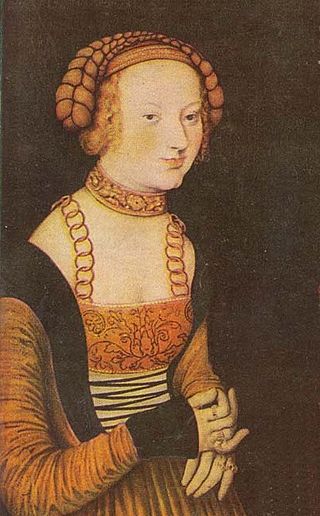
Albert III was a Duke of Saxony. He was nicknamed Albert the Bold or Albert the Courageous and founded the Albertine line of the House of Wettin.

George of Brandenburg-Ansbach, known as George the Pious, was a Margrave of Brandenburg-Ansbach from the House of Hohenzollern.

George the Bearded was Duke of Saxony from 1500 to 1539 known for his opposition to the Reformation. While the Ernestine line embraced Lutheranism, the Albertines were reluctant to do so. Despite George's efforts to avoid a succession by a Lutheran upon his death in 1539, he could not prevent it from happening. Under the Act of Settlement of 1499, Lutheran Henry IV became the new duke. Upon his accession, Henry introduced Lutheranism as a state religion in the Albertine lands of Saxony.

Year 1539 (MDXXXIX) was a common year starting on Wednesday of the Julian calendar.

Johann George III was Elector of Saxony from 1680 to 1691. He belonged to the Albertine branch of the House of Wettin.

Maurice was Duke (1541–47) and later Elector (1547–53) of Saxony. His clever manipulation of alliances and disputes gained the Albertine branch of the Wettin dynasty extensive lands and the electoral dignity.

The Duchy of Saxe-Lauenburg, was a reichsfrei duchy that existed from 1296 to 1803 and again from 1814 to 1876 in the extreme southeast region of what is now Schleswig-Holstein. Its territorial center was in the modern district of Herzogtum Lauenburg and originally its eponymous capital was Lauenburg upon Elbe, though the capital moved to Ratzeburg in 1619.

Ernest of Brunswick-Lüneburg, also frequently called Ernest the Confessor, was duke of Brunswick-Lüneburg and a champion of the Protestant cause during the early years of the Protestant Reformation. He was the Prince of Lüneburg and ruled the Lüneburg-Celle subdivision of the Welf family's Brunswick-Lüneburg duchy from 1520 until his death.

Frederick III, Duke of Legnica was a Duke of Legnica during 1547–1551 and 1556–1559.

Sophie of Brandenburg was Electress of Saxony by marriage to Christian I, Elector of Saxony. She was regent from 1591 to 1601 during the minority of their son Christian II.

Eric I, the Elder was Duke of Brunswick-Lüneburg from 1495 and the first reigning prince of Calenberg-Göttingen.

Sidonie of Poděbrady was a duchess consort of Saxony, as the wife of Albert III. She was a daughter of George of Poděbrady, King of Bohemia, and his first wife Kunigunde of Sternberg. She was the twin sister of Catherine of Poděbrady, wife of Matthias Corvinus of Hungary.

Catherine of Mecklenburg, was a Duchess of Saxony by marriage to Henry IV, Duke of Saxony. She was the daughter of the Duke Magnus II of Mecklenburg and Sophie of Pomerania-Stettin.
Sophie of Brandenburg-Ansbach was a princess of Brandenburg-Ansbach and by marriage Duchess of Legnica.

Emilie of Saxony was Margravine of Brandenburg-Ansbach as the third wife of Margrave George the Pious of Brandenburg-Ansbach. Since his two earlier wives died before his accession, she was the only one to hold the title of Margravine.
Dorothy Catherine of Brandenburg-Ansbach was a princess of Brandenburg-Ansbach and by marriage burgravine of Meissen.

Sidonie of Saxony was a princess of the House of Wettin and by marriage Duchess of Brunswick-Lüneburg and Princess of Calenberg-Göttingen.

Severinus of Saxony was a Saxon prince of the Albertine line of the House of Wettin.
Frederick, Hereditary Prince of Saxony was a German nobleman and member of the Albertine branch of the House of Wettin.























